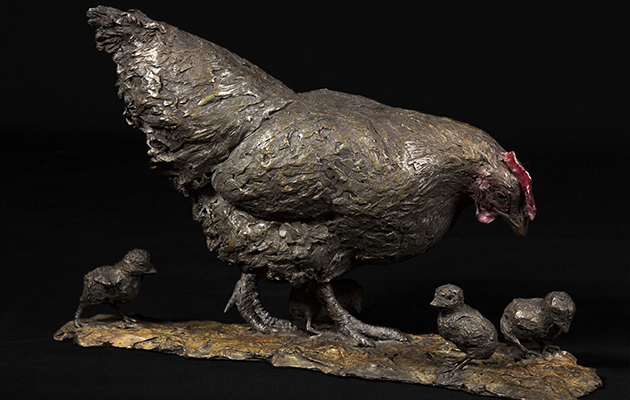Size might not matter, sculptor Knox Field tells Janet Menzies, but gravitas certainly does
Knox Field and his abstract, yet closely observed, sculptures are a rarity in wildlife art. Size doesn’t matter, he explains to Janet Menzies, it is gravitas that is important.
For more sporting artists, Justin Prigmore uses close and careful study to capture his subjects with such precision. And Tanja Möderscheim was inspired by her country’s heritage tulips and the Dutch Masters to forge a career as an artist.
KNOX FIELD
What is the difference between a chicken and an elephant? No, that’s not a schoolboy joke but something that feels surprisingly worth thinking about when viewing Knox Field’s two bronzes, one of an elephant and another of a hen with chicks, placed side by side.

African Bull Elephant.
“At about 45cm high, the hen is actually slightly bigger than the elephant,” Field admits, humour not that far from his mind. “With the hen, I did want to put a bit of comedy into the scene, with her four little chicks that I imagine saying, ‘I don’t want to be a nugget.’”
It turns out that, to an artist, the difference between a chicken and an elephant isn’t size but gravitas. Field explains: “Of all animals, the elephant is special. They have such expressive faces and they have such weightiness to them. I can’t explain it in words but there is something solemn about them, almost a sadness, that I want to express in sculpture.”
Despite his respect for the elephant, Field’s first love is the tiger and it was this that inspired him to become a sculptor while still in his teens. “I was a bit turbulent at school and my father tried to motivate me by taking me to visit the famous sculptor Mark Coreth. He was talking me through how to make sculpture and asked me what I would like to sculpt – and it was tigers, immediately. I keep coming back to them and I so much want to get into India to see them in the wild.”

Tiger – Field’s first love.
With Coreth taking him under his wing, Field’s teenage angst evaporated as he began to grapple with his newfound art. “I worked at a bronze casting foundry for three years to get an understanding of the medium and how it works, and now I want to push it as far as I can. For example, texture is very strong in my work. I made a labradoodle and I wanted to see how far I could go with its hair, the strands and the shagginess, so the hair had to be silver-soldered onto it after the casting. To get the textures I want, the material is pulled and stretched to extremes.
“When I started sculpting, at first you look at the whole animal but now I am looking at the individual small aspects – the muscle texture, the hair and the skin. I want this minutely observed detail to become a thing in itself.”
ALMOST ABSTRACT
Of course, at this level, size becomes a less important attribute. In fact, Field’s quest is leading him away from three-dimensional, representational sculpture into an area that is almost abstract. He explains: “I have started working on flat copper plate. Each plate is etched with one element – perhaps skin or hair – and I am very interested in the texture and the detail, and I want that to be the true value. I want to go on a journey into abstract sculpture.”

Knox Field working on Fallow Buck.
Field’s idea of abstraction in closely observed detail is rare in wildlife art, which usually concentrates on accurate, figurative representations of animals and their environment. Sporting and wildlife art is sometimes criticised for its tendency towards a pragmatic, photographic approach. In the 18th century, it was dismissed as a lower order of art because it was considered to make no commentary on its subject. So Field’s approach is refreshing, and he is trying to bring it into his commissioned work. “Now that I am finding this more abstracted way of working, it would be nice to bring it into the sculpture and to work with different materials and go on a journey with it.”
Field’s next big plan is literally a journey. “I want to go out to Africa and spend time with the animals. But I haven’t any preconceived ideas of what it will be like. I know that the moment I arrive, there will be so much variety and so much going on. So I don’t want to limit my view, I want to go out with open eyes.”

Laradoodle – the hair was silver-soldered on afterwards to get the shaggy effect.
Field hopes that by seeing – and feeling – the animals in a different way, his work will develop further. Even in his commissioned work, he explains: “I try to get the personality and what I feel about animals. For that reason I love doing domestic animals. If I do a dog, I need to meet that dog and hopefully do the sculpture with the dog there. And I like having a range of different animals represented in my work.”

The completed Fallow Buck.
Certainly Field’s portfolio portrays a menagerie worthy of Noah’s ark, from the bronze of Texas, the founding father of a herd of South African water buffalo, to a life-size fallow deer. He comments: “The scale of the fallow deer came to me because I live in fallow country in West Sussex and I see them all the time, I have a connection with them.”
So sometimes size does matter – but only as an expression of feeling.
To view Knox Field’s work online, visit: knox-field.co.uk or call 07810 595615.
To learn about Indian tiger conservation, visit: https://projecttiger.nic.in





